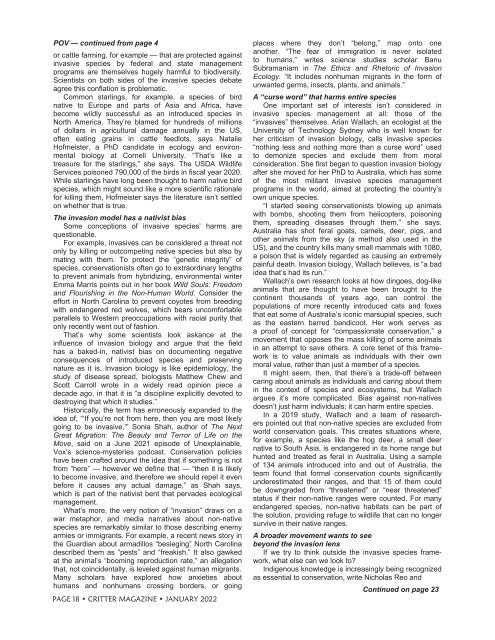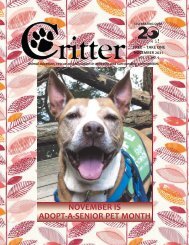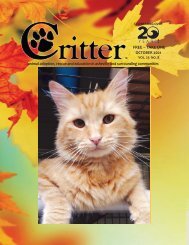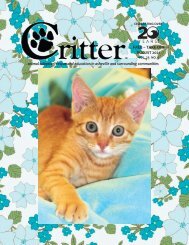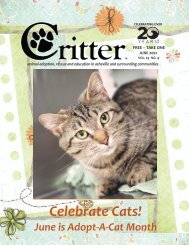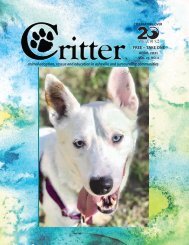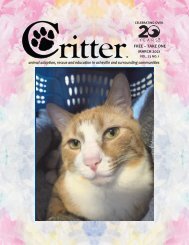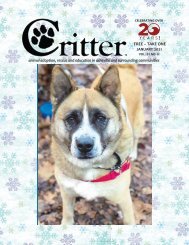Create successful ePaper yourself
Turn your PDF publications into a flip-book with our unique Google optimized e-Paper software.
POV — continued from page 4<br />
or cattle farming, for example — that are protected against<br />
invasive species by federal and state management<br />
programs are themselves hugely harmful to biodiversity.<br />
Scientists on both sides of the invasive species debate<br />
agree this conflation is problematic.<br />
Common starlings, for example, a species of bird<br />
native to Europe and parts of Asia and Africa, have<br />
become wildly successful as an introduced species in<br />
North America. They’re blamed for hundreds of millions<br />
of dollars in agricultural damage annually in the US,<br />
often eating grains in cattle feedlots, says Natalie<br />
Hofmeister, a PhD candidate in ecology and environmental<br />
biology at Cornell University. “That’s like a<br />
treasure for the starlings,” she says. The USDA Wildlife<br />
Services poisoned 790,000 of the birds in fiscal year 2020.<br />
While starlings have long been thought to harm native bird<br />
species, which might sound like a more scientific rationale<br />
for killing them, Hofmeister says the literature isn’t settled<br />
on whether that is true.<br />
The invasion model has a nativist bias<br />
Some conceptions of invasive species’ harms are<br />
questionable.<br />
For example, invasives can be considered a threat not<br />
only by killing or outcompeting native species but also by<br />
mating with them. To protect the “genetic integrity” of<br />
species, conservationists often go to extraordinary lengths<br />
to prevent animals from hybridizing, environmental writer<br />
Emma Marris points out in her book Wild Souls: Freedom<br />
and Flourishing in the Non-Human World. Consider the<br />
effort in North Carolina to prevent coyotes from breeding<br />
with endangered red wolves, which bears uncomfortable<br />
parallels to Western preoccupations with racial purity that<br />
only recently went out of fashion.<br />
That’s why some scientists look askance at the<br />
influence of invasion biology and argue that the field<br />
has a baked-in, nativist bias on documenting negative<br />
consequences of introduced species and preserving<br />
nature as it is. Invasion biology is like epidemiology, the<br />
study of disease spread, biologists Matthew Chew and<br />
Scott Carroll wrote in a widely read opinion piece a<br />
decade ago, in that it is “a discipline explicitly devoted to<br />
destroying that which it studies.”<br />
Historically, the term has erroneously expanded to the<br />
idea of, “‘If you’re not from here, then you are most likely<br />
going to be invasive,’” Sonia Shah, author of The Next<br />
Great Migration: The Beauty and Terror of Life on the<br />
Move, said on a June 2021 episode of Unexplainable,<br />
Vox’s science-mysteries podcast. Conservation policies<br />
have been crafted around the idea that if something is not<br />
from “here” — however we define that — “then it is likely<br />
to become invasive, and therefore we should repel it even<br />
before it causes any actual damage,” as Shah says,<br />
which is part of the nativist bent that pervades ecological<br />
management.<br />
What’s more, the very notion of “invasion” draws on a<br />
war metaphor, and media narratives about non-native<br />
species are remarkably similar to those describing enemy<br />
armies or immigrants. For example, a recent news story in<br />
the Guardian about armadillos “besieging” North Carolina<br />
described them as “pests” and “freakish.” It also gawked<br />
at the animal’s “booming reproduction rate,” an allegation<br />
that, not coincidentally, is leveled against human migrants.<br />
Many scholars have explored how anxieties about<br />
humans and nonhumans crossing borders, or going<br />
PAGE 18 • CRITTER MAGAZINE • JANUARY 2022<br />
places where they don’t “belong,” map onto one<br />
another. “The fear of immigration is never isolated<br />
to humans,” writes science studies scholar Banu<br />
Subramaniam in The Ethics and Rhetoric of Invasion<br />
Ecology. “It includes nonhuman migrants in the form of<br />
unwanted germs, insects, plants, and animals.”<br />
A “curse word” that harms entire species<br />
One important set of interests isn’t considered in<br />
invasive species management at all: those of the<br />
“invasives” themselves. Arian Wallach, an ecologist at the<br />
University of Technology Sydney who is well known for<br />
her criticism of invasion biology, calls invasive species<br />
“nothing less and nothing more than a curse word” used<br />
to demonize species and exclude them from moral<br />
consideration. She first began to question invasion biology<br />
after she moved for her PhD to Australia, which has some<br />
of the most militant invasive species management<br />
programs in the world, aimed at protecting the country’s<br />
own unique species.<br />
“I started seeing conservationists blowing up animals<br />
with bombs, shooting them from helicopters, poisoning<br />
them, spreading diseases through them,” she says.<br />
Australia has shot feral goats, camels, deer, pigs, and<br />
other animals from the sky (a method also used in the<br />
US), and the country kills many small mammals with 1080,<br />
a poison that is widely regarded as causing an extremely<br />
painful death. Invasion biology, Wallach believes, is “a bad<br />
idea that’s had its run.”<br />
Wallach’s own research looks at how dingoes, dog-like<br />
animals that are thought to have been brought to the<br />
continent thousands of years ago, can control the<br />
populations of more recently introduced cats and foxes<br />
that eat some of Australia’s iconic marsupial species, such<br />
as the eastern barred bandicoot. Her work serves as<br />
a proof of concept for “compassionate conservation,” a<br />
movement that opposes the mass killing of some animals<br />
in an attempt to save others. A core tenet of this framework<br />
is to value animals as individuals with their own<br />
moral value, rather than just a member of a species.<br />
It might seem, then, that there’s a trade-off between<br />
caring about animals as individuals and caring about them<br />
in the context of species and ecosystems, but Wallach<br />
argues it’s more complicated. Bias against non-natives<br />
doesn’t just harm individuals; it can harm entire species.<br />
In a 2019 study, Wallach and a team of researchers<br />
pointed out that non-native species are excluded from<br />
world conservation goals. This creates situations where,<br />
for example, a species like the hog deer, a small deer<br />
native to South Asia, is endangered in its home range but<br />
hunted and treated as feral in Australia. Using a sample<br />
of 134 animals introduced into and out of Australia, the<br />
team found that formal conservation counts significantly<br />
underestimated their ranges, and that 15 of them could<br />
be downgraded from “threatened” or “near threatened”<br />
status if their non-native ranges were counted. For many<br />
endangered species, non-native habitats can be part of<br />
the solution, providing refuge to wildlife that can no longer<br />
survive in their native ranges.<br />
A broader movement wants to see<br />
beyond the invasion lens<br />
If we try to think outside the invasive species framework,<br />
what else can we look to?<br />
Indigenous knowledge is increasingly being recognized<br />
as essential to conservation, write Nicholas Reo and<br />
Continued on page 23


